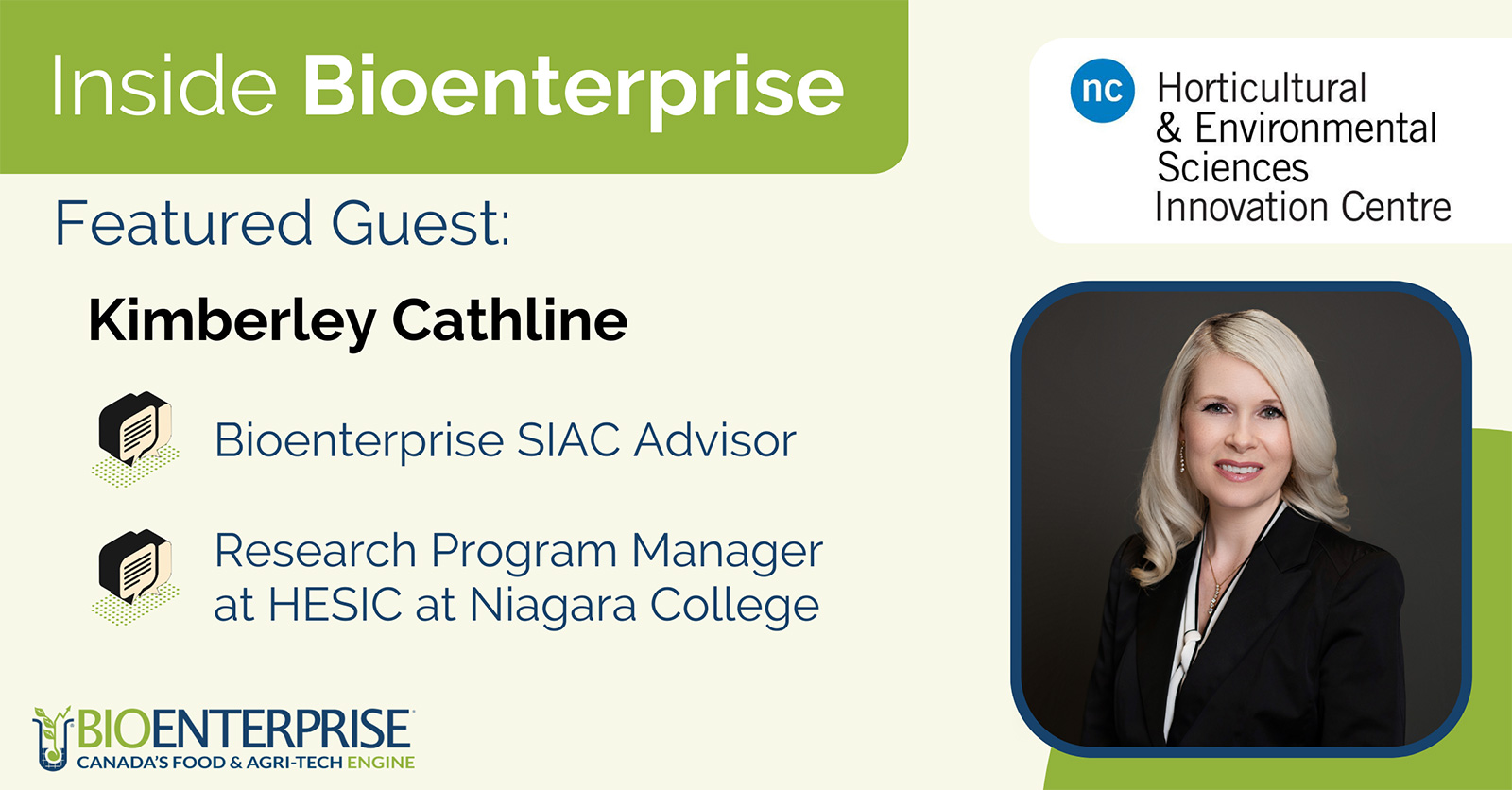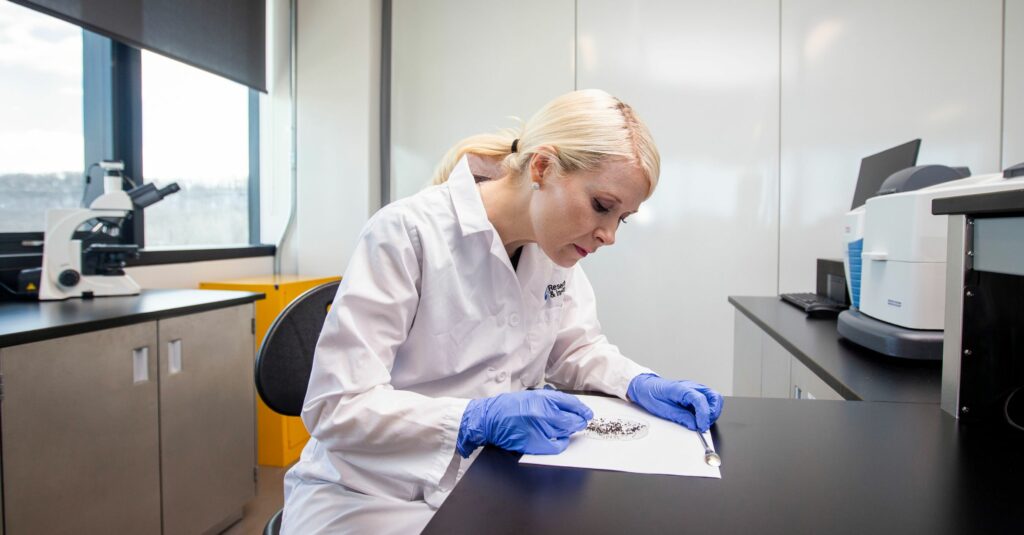
Kimberley Cathline, Research Program Manager at the Horticultural & Environmental Sciences Innovation Centre (HESIC) at Niagara College (NC) and Bioenterprise Advisor, discusses the value of applied research and academic-industry partnerships and shares advice for women and other leaders in the agriculture and horticulture sectors
By Tabitha Caswell for Bioenterprise
In the field of North American applied research in agriculture, Kimberley Cathline stands out as an exemplary leader and role model. Over the past two decades, she has quietly but powerfully shattered stereotypes, becoming an inspiration for other women. From academia to business and beyond, Kimberley has built a case that there is a place for everyone in this ever-evolving industry – a case built on her stellar reputation of communication, dedication, and hard work.
Today, Kimberley is the Research Program Manager at the Horticultural & Environmental Sciences Innovation Centre (HESIC) at Niagara College (NC) and a valued member of the Science and Innovation Advisory Committee (SIAC) at Bioenterprise Canada. Here, she shares her unique journey, discusses her perspective on the importance of applied research in agriculture, gives us an update on the program changes and expansion at NC, and offers words of wisdom for aspiring women and others in influential roles.

Cultivating a Culture of Leadership
Kimberley’s story stems from a childhood fascination with the natural sciences. From an early age, her innate curiosity led her down a path of exploring the intricacies of the plant world, particularly the marvels of cellular systems and the harmonious synergy found in their sophisticated design.
Nurtured by supportive mentors and driven by her passion for plants, Kimberley decided to further pursue her interests academically, sensibly landing at the University of Guelph (U of G), known for its strong horticulture and agriculture programs. In 2002 she earned a Bachelor of Science degree (Hon. with distinction) from the U of G, where she studied plant biology and genetics.
Kimberley spent the summer breaks during her undergrad working in a plant physiology research lab within the Department of Botany on the U of G campus and she also won an internship placement with the National Research Council of Canada at the Plant Biotechnology Institute in Saskatoon. While still a student, these hands-on laboratory experiences made an influential, positive impact on Kimberley’s future career path in applied research.
In 2005, Kimberley accepted a position working with Dr. Matthew Fidelibus in the Department of Viticulture & Enology at the University of California, Davis (UC Davis). At the time, the lab was one of a few in the world performing applied research with all three types of grapes including table grapes, wine grapes, and raisin grapes.
After eight years of working and living in California, it’s safe to say Kimberley knows a thing or two about wine. But beyond that, witnessing the impact of her work on growers and partner companies at UC Davis was highly rewarding for Kimberley, framing the foundation for her career in applied science.
Eventually, the lure of Niagara wine country brought Kimberley and her family back to Ontario in 2013 when she accepted a Senior Research Technician role with Vineland Research & Innovation Centre. There, she evolved through various positions, landing as the Manager, Special Projects and Corporate Secretary. In 2017 Kimberley also earned her Master of Science degree in Biological Sciences (Plant Science and Oenology and Viticulture) from Brock University.
Her current role as Research Program Manager with HESIC is uniquely suited to showcase Kimberley’s expertise in horticulture science, paired with her strong administrative and management skills. Through her multifaceted career, Kimberley has accumulated a bounty of practical experience balancing her work in academia and as a liaison with the private sector and the government in areas like communications and funding.
Beyond her professional endeavours, Kimberley finds immense personal satisfaction in volunteering in her community, particularly placing her attention on disadvantaged children. While her work at HESIC aims to assist the needs of industry, growers, and emerging commercial producers, when it comes to food security her interest in feeding hungry children hits close to home.
“Like many people, I was shocked to learn that some children in Canada, right here in my region of Ontario, go without school lunches, and I was compelled to do something about it,” she says. Kimberley recently put her volunteer roles on hold, but for good reason: over the past four years she’s been reshaping the program at HESIC, building her team there, and working toward an exciting expansion at the Daniel J. Patterson campus in Niagara-on-the-Lake.

Niagara’s Oasis of Learning and Innovation
Nestled within the heart of Ontario, the Niagara region shines as a botanical marvel. Here, a unique microclimate sits at Canada’s doorstep. Warm air currents from Lake Ontario embrace the land, creating a temperate haven for agriculture, horticulture, and viticulture. The region’s rolling vineyards and lush orchards bask in the gentle caress of this zone, producing some of Canada’s finest wines and produce.
The region’s allure also lies in its ability to harmonize tradition with innovation. It’s a living laboratory for greenhouse research, where aspiring scientists and entrepreneurs find inspiration amidst this verdant oasis. This makes the Niagara region an ideal location for a teaching college dedicated to nurturing the future of ag, and that is precisely one of the reasons why NC is so sought after.
For the second time in less than five years, Research Infosource released a report in which NC claimed the number one position for colleges in Canada in funding, and they’ve maintained their status among the top ten colleges on this list nine years in a row.
“Part of our attraction for students lies in their access to hands-on work, and we can give them that here in this microclimate. We can grow the grapes, and students can actually prune, tend, and harvest them. They can actively participate in their studies,” Kimberley says.
“This unique climate is one of the reasons why certain programs like Horticulture Technician, Landscape Technician, Winery and Viticulture Technician, and especially Greenhouse Technician, have been successful. But it’s also because the College is always analyzing the industry and its demand for labour. The team here considers what’s relevant to the region and works diligently to align our programs accordingly,” she says.
Niagara College also boasts a comprehensive Cannabis Production program and Kimberley points out that it was one of the earliest to offer a program of this kind. “The team is always on top of new industry trends and consistently developing ways to pivot and ensure our programs satisfy those industry demands,” she says.
When Kimberley arrived at NC, the program had a different name and focus, known as the Agriculture & Environmental Technologies Innovation Centre (AETIC). Over the last four years, she has been leading the innovation centre through a metamorphosis. Through the Greenhouse Technology Network, they secured funding and paired that with financial support from the College and Niagara Region. “We’re thrilled with this backing to build a dedicated research greenhouse for the centre because it will strengthen our place on the map as a high-quality research institute,” she says. With her support and guidance, Kimberley has bolstered growth, expanding her team of students and staff to 11, and she predicts consistent progress and growth as the centre evolves. So, when will the project be completed?
“After almost four years of planning, we broke ground this past July, so construction is currently underway, and if the timeline remains on track, we expect to finish by September 2024. I think this year will be an amazing one for the College and for HESIC!” Kimberley says.
Capitalizing on the unique microclimate in which it’s positioned, the future success of horticulture- and agriculture-related programs at NC looks bright. Kimberley envisions it as a haven where students and future leaders in agriculture from across Canada and around the world come to learn in the highest-level environment with access to hands-on experience through applied research.

The Impact of Research in Action
Research can be broken into two basic categories: theoretical research and applied research. Theoretical research is focused on developing and testing novel theories, but often without immediate practical applications. Its purpose is to expand our knowledge and understanding, so we can think of this as “exploratory” research.
In contrast, applied research is directed toward solving real-world problems or developing practical solutions. While using the knowledge developed theoretically, its purpose is to address practical issues or improve processes. It often involves hands-on experimentation, data collection, and analysis, building upon existing theoretical research.
So why is applied research important for advancing innovation in agriculture and horticulture? As an expert on this topic, Kimberley says, “Of course there’s value in theoretical research, but where the value of applied research really shines is in the impact it has on real-world businesses. We can use it to build on that theoretical foundation to assist businesses, to help move their products ahead, and catapult their innovations and technologies toward commercialization.”
This is an element unique to the programs at NC. “Being involved with this end of the process, for a student or researcher, is very rewarding because you can put the theory into practice and witness a tangible product make it to market. Seeing a product on store shelves or measuring the growth of acres in a field is huge. To be in a position where we can positively change people’s lives is a wonderful thing to experience,” Kimberley says.
From Research to Revenue
Among recent success stories, Kimberley highlights two partnerships between the College and innovators who are accelerating their businesses beyond expectations.
SoilOptix®, a technology and software company based in Tavistock, Ontario, partnered with the Research & Innovation division at NC in 2017. Also boosted by guidance and funding support through Bioenterprise Canada, the company is breaching the boundaries of traditional soil analysis and mapping via highly accurate precision tech that allows farmers to identify previously missed gaps to offer a finely tuned and customized approach to soil amendment.
During this collaboration, the team at HESIC identified and helped to develop a critical key to their success: automation. Since working together, the data analysis process that once took about eight hours to complete has been dramatically reduced to mere minutes and will soon likely be achieved in only a few seconds.
Another story of success out of HESIC comes from a partnership with the Canadian company, International Zeolite Corp. (IZ). Zeolites are minerals known for their porous structure and ability to selectively adsorb molecules and ions making them valuable in numerous practical applications, notably in the agriculture sector. Zeolites have demonstrated remarkable function in the production of animal feed, fertilizers and other soil amendments, as well as in processes like environmental remediation, waste management, and water filtration.
The team at HESIC has supported the development of NEREA®, a product that facilitates an alternative to traditional growing systems. The product shows the potential to regulate moisture and control the nutrient pathway, as this innovation aims to eliminate the complexities of circulation, measurement, and monitoring of traditional systems.
As with SoilOptix®, IZ was supported in its growth with mentorship and funding opportunities through Bioenterprise Canada. IZ was chosen as a recipient of the Fertilizer Accelerating Solutions & Technology Challenge in 2021, recognizing the company’s efforts to offer alternatives and reduce dependency on imported fertilizers for the agriculture sector.
The partnership between innovators and HESIC is a mutually beneficial one. The companies move their products toward successful commercialization while students gain valuable hands-on experience. Kimberley says that the success of these partnerships stems from collaboration and the intentional structure of those collaborative groups.
“We seek to build relationships with strong partners, and when these partners work with us, we design each team with solid representation. It’s always a combination of the industry partner, an expert in the field who could be one of our on-staff researchers or a faculty member, as well as students. I currently have six students on my team and they’re very active on projects. They’re an integral part of the process. Our industry partners are enthusiastic about the idea of having students on the team, and many end up hiring our students.”
While representation of diverse stakeholders is an important factor in these stories of success, it’s also top of mind when it comes to Kimberley’s leadership style.

Breaching the Gender Gap in Ag and STEM
According to Statistics Canada, the enrollment of women in Science, Technology, Engineering, and Mathematics (STEM) related post-secondary programs is on the rise. They also report an increase in women-led farming operations. While these are positive affirmations, there is still much progress left to be made.
Women comprise only about 25 percent of the individuals working in STEM careers in Canada. Fostering the untapped resources that exist within this demographic could be key for Canada to reach its net-zero emissions goal by the year 2050. The STEM gender gap is a complicated one to dissect, but we can all contribute to positive change by acknowledging and bringing awareness to this topic.
Kimberley says that although it can feel “normalized,” for many women, it’s true that she often sits in meetings surrounded by a table of men. “It’s hard, sometimes. But I believe a woman’s voice needs to be heard. We have important things to say and contributions to make to these conversations that can bring value to the industry,” she says.
Eliminating biased practices, creating supportive learning environments, modifying teaching methods, and providing active mentorship for women are strategies to adopt and promote. When Kimberley reflects on her career, she attributes her success to mentors who encouraged and supported her along the way. “In more than one case, someone noticed potential in me and pointed it out. It gave me confidence in my education and my career,” she says.
For women and girls interested in entering agri-tech, or STEM-related fields she offers advice. “Take opportunities that are presented to you, and never think that you’re not enough or that you lack qualifications to move forward. Be willing to work hard and take risks, and be confident in your abilities,” Kimberley says.
And for those in existing leadership roles who have a voice and the ability to influence and support others, she makes a request, “Please try to recognize the potential value in people and take opportunities to help grow them. Some people don’t always see it in themselves, so you need to step in and pull it out of them and build them up. If you’re in a position to help shape the future for someone, especially for a woman, you can make a significant difference in their life.”
Kimberley Cathline is a visionary who reimagines the learning environment for the next generation of agriculture professionals at Niagara College. Standing as a role model for women and other leaders, her humility and dedication to her team and her students show us that the seeds of passion, hard work, and inclusivity can indeed bear the richest fruits in Canada’s future ag-tech landscape.
Follow Bioenterprise on social media or subscribe to our channels for the latest industry news, events, and business development opportunities.